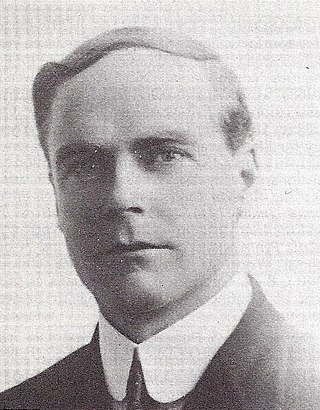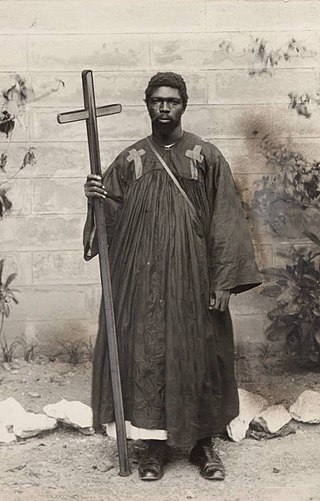Related Research Articles
Speaking in tongues, also known as glossolalia, is an activity or practice in which people utter words or speech-like sounds, often thought by believers to be languages unknown to the speaker. One definition used by linguists is the fluid vocalizing of speech-like syllables that lack any readily comprehended meaning. In some cases, as part of religious practice, some believe it to be a divine language unknown to the speaker. Glossolalia is practiced in Pentecostal and charismatic Christianity, as well as in other religions.
Pentecostalism or classical Pentecostalism is a Protestant Charismatic Christian movement that emphasizes direct personal experience of God through baptism with the Holy Spirit. The term Pentecostal is derived from Pentecost, an event that commemorates the descent of the Holy Spirit upon the Apostles and other followers of Jesus Christ while they were in Jerusalem celebrating the Feast of Weeks, as described in the Acts of the Apostles.

In Christianity, evangelism or witnessing is the act of preaching the gospel with the intention of sharing the message and teachings of Jesus Christ.
The Azusa Street Revival was a historic series of revival meetings that took place in Los Angeles, California. It was led by William J. Seymour, an African-American preacher. The revival began on April 9, 1906, and continued until roughly 1915.
The Pentecostal World Fellowship is an international fellowship of Evangelical Pentecostal churches and denominations from across the world. The headquarters is in Tulsa, Oklahoma. Its leader is William Wilson.

William Joseph Seymour was an African-American holiness preacher who initiated the Azusa Street Revival, an influential event in the rise of the Pentecostal and Charismatic movements. He was the second of eight children born to emancipated slaves and raised Catholic in extreme poverty in Louisiana.

Charles F. Parham was an American preacher and evangelist. Together with William J. Seymour, Parham was one of the two central figures in the development and early spread of American Pentecostalism. It was Parham who associated glossolalia with the baptism in the Holy Spirit, a theological connection crucial to the emergence of Pentecostalism as a distinct movement. Parham was the first preacher to articulate Pentecostalism's distinctive doctrine of evidential tongues, and to expand the movement.

The Apostolic Faith Mission of South Africa (AFM) is a classical Pentecostal Christian denomination in South Africa. With 1.2 million adherents, it is South Africa's largest Pentecostal church and the fifth largest religious grouping in South Africa representing 7.6 percent of the population. Dr. Isak Burger has led the AFM as president since 1996 when the white and black branches of the church were united. It is a member of the Apostolic Faith Mission International, a fellowship of 23 AFM national churches. It is also a member of the South African Council of Churches.

Religion of black Americans refers to the religious and spiritual practices of African Americans. Historians generally agree that the religious life of black Americans "forms the foundation of their community life". Before 1775 there was scattered evidence of organized religion among black people in the Thirteen Colonies. The Methodist and Baptist churches became much more active in the 1780s. Their growth was quite rapid for the next 150 years, until their membership included the majority of black Americans.
The Finished Work is a doctrine associated with Pentecostals of the Finished Work Pentecostal tradition, that locates sanctification at the time of conversion; afterward the converted Christian progressively grows in grace. This is contrary to the Wesleyan doctrine of entire sanctification that locates complete sanctification in a definite second work of grace which Holiness Pentecostals teach is a necessary prerequisite to receive the baptism in the Holy Spirit. The term finished work arises from the aphorism "It's a Finished Work at Calvary", referring to both salvation and sanctification. Though the term is used within Pentecostal Christianity, it is not exclusively a Pentecostal doctrine.

William Howard Durham was an early Pentecostal preacher and theologian, best known for advocating the Finished Work doctrine.

William Wadé Harris was a Liberian Grebo evangelist, who preached in Liberia, Côte d'Ivoire and Ghana. He has been described as the "most extraordinary one man evangelical crusade that Africa has ever known" and is considered one of the originators of today's prosperity gospel.
Allan Anderson is a British theologian and the Professor of Mission and Pentecostal Studies at the University of Birmingham. He is frequently cited as one of the foremost scholars on Global Pentecostalism.
Pentecostalism is a renewal movement within Protestant Christianity that places special emphasis on a direct personal relationship with God and experience of God through the baptism with the Holy Spirit. For Christians, this event commemorates the descent of the Holy Spirit upon the followers of Jesus Christ, as described in the second chapter of the Book of Acts. Pentecostalism was established in Kerala, India at the start of the 20th century.

Pentecostalism in Australia is a large and growing Christian movement. Pentecostalism is a renewal movement within Protestant Christianity that places special emphasis on a direct personal experience of God through baptism with the Holy Spirit. It emerged from 19th century precursors between 1870 and 1910, taking denominational form from c. 1927. From the early 1930s, Pentecostal denominations multiplied, and there are now several dozen, the largest of which relate to one another through conferences and organisations such as the Australian Pentecostal Ministers Fellowship. The Australian Christian Churches, formerly known as the Australian Assemblies of God, is the oldest and longest lasting Pentecostal organisation in Australia. The AOG/ACC is also the largest Pentecostal organisation in Australia with over 300,000 members in 2018. Until 2018, Hillsong Church was one of 10 megachurches in Australia associated with the ACC that have at least 2,000 members weekly. According to the church, over 100,000 people attend services each week at the church or one of its 80 affiliated churches located worldwide.
Pentecostalism began spreading in South Africa after William J. Seymour, of the Azusa Street mission, sent missionaries to convert and organize missions. By the 1990s, approximately 10% of the population of South Africa was Pentecostal. The largest denominations were the Apostolic Faith Mission, Assemblies of God, and the Full Gospel Church of God. Another 30% of the population was made up of mostly black Zionist and Apostolic churches, which comprise a majority of South Africa's African Instituted Churches(AICs). In a 2006 survey, 1 in 10 urban South Africans said they were Pentecostal, and 2 in 10 said they were charismatic. In total, renewalists comprised one-fourth of the South African urban population. A third of all protestants surveyed said that they were Pentecostal or charismatic, and one-third of all South African AIC members said they were charismatic.

Samson Kwame Oppong also Sampson Opon or Opong was a controversial Akan Christian preacher-prophet on the Gold Coast in the 1920s. His missionary zeal, unconventional and fiery ministry helped entrench Methodism in the Ashanti and Brong-Ahafo Regions of Ghana, through a large-scale spiritual awakening and revival. Though his knowledge of Christian theology was minimal, he is known to have employed threats and other coercive techniques to proselytise in the Ghanaian towns and villages he worked in.
Edith Lydia Waldvogel Blumhofer was a Harvard educated historian whose teaching and publications gave the study of American Pentecostalism a respected place in the history of religion and scholarly research.
Margaret Peoples Shirer was an American missionary and one of the first Pentecostal Christian missionaries to West Africa. With little formal education, at the age of twenty-two, she traveled to Burkina Faso in 1919 with the support of the Assemblies of God. In order to spread the vision of Pentecostal Christianity and to convert people to believers, Margaret Peoples became the first known Western person to learn the language of the Mossi people. She translated portions of the Bible into the Mossi language, Mooré, and used Mossi stories in her preaching. After marrying a fellow missionary, W. Lloyd Shirer, the couple became the first to open an Assemblies of God missions office in Ghana. Shirer learned the Dagbani language in Ghana and translated the biblical books of Matthew, Mark, Acts, Ephesians, 1 Peter into the language. Shirer also served as a missionary for the Assemblies of God in Nigeria. After losing the sponsorship of the Assemblies of God, the couple continued to preach the Pentecostal Christian message in other countries, including Congo and Haiti. After Lloyd Shirer's death in 1972, she moved to Springfield, Missouri, where she recruited others for the mission field.
References
- 1 2 3 4 5 6 7 8 Anderson, Allan. Evangelism and the Growth of Pentecostalism in Africa. University of Birmingham, 2000.
- 1 2 3 4 5 Corten, André, and Ruth Marshall. Between Babel and Pentecost. Bloomington: Indiana UP, 2001. 216-30. Print.
- 1 2 3 4 Kalu, Ogbu. African Pentecostalism: An Introduction. Oxford: Oxford UP, 2008. Print.
- 1 2 3 Anderson, Allan. New African Initiated Pentecostalism and Charismatics in South Africa. Journal of Religion in Africa, Vol. 35. 2005.
- 1 2 3 4 5 6 Espinosa, Gastón. William J. Seymour and the Origins of Global Pentecostalism: A Biography and Documentary History. Duke UP, 2014. Print.
- 1 2 3 4 5 6 Lindhart, Martin (2014-12-01). Pentecostalism in Africa: presence and impact of pneumatic Christianity in postcolonial societies. Brill. ISBN 9789004281868.
- 1 2 3 4 5 Shank, David. "The legacy of William Wade Harris". International Bulletin of Missionary Research.
- ↑ "Church of Christ - Harris Mission (Harrist Church) — World Council of Churches". www.oikoumene.org. Retrieved 2018-10-23.
- ↑ "Young Nigerians are connecting with Pentecostal churches. Will they return to Catholicism?". America Magazine. 2017-11-16. Retrieved 2018-03-19.
- ↑ "Pentecostal and Charismatic Movements in Ethiopia — European Research Network on Global Pentecostalism". www.glopent.net. Retrieved 2015-05-01.